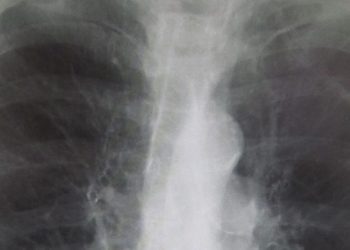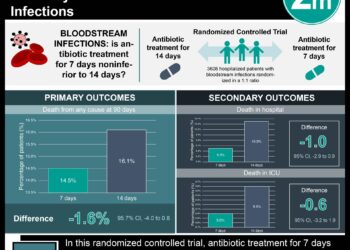#VisualAbstract: Tendon injuries associated with fluoroquinolone use in adolescents are extremely rare
1. In a large retrospective cohort study, adolescents prescribed fluoroquinolone antibiotics were at a slightly increased risk of experiencing tendinitis or tendon rupture compared to those who took other antibiotics.
2. The increased risk of tendon rupture associated with fluoroquinolone use was extremely small, with a number needed to treat to harm of more than 52,000.
Evidence Rating Level: 2 (Good)
Study Rundown: Studies in adult populations have found fluoroquinolone antibiotics to be associated with an increased risk of tendon injury. This has contributed to safety concerns regarding their use in pediatric populations, and overall lower rates of prescribing. This study sought to assess these concerns of tendon injury in adolescents using data from a cohort of over 4 million adolescents spanning across 18 years. Tendon rupture and tendinitis were compared in a group of outpatient adolescents who used fluoroquinolone antibiotics to a group who used other, similarly broad-spectrum antibiotics prescribed for the same clinical indications. Researchers found that while there was indeed a risk increase associated with fluoroquinolones, this risk was quite small and tendon injury events were rare in both groups. Although rare, the risk of tendinitis was relatively higher than the risk of tendon rupture. Although somewhat limited by its retrospective cohort design and including only those enrolled in employer-sponsored private insurance plans, this study is strengthened by its large sample size and adjustment for possible confounders. As fluoroquinolones are broad-spectrum antibiotics with high oral bioavailability, the rarity of these adverse effects should reassure clinicians regarding the safety of these medications in adolescents.
Click to read the study in PEDIATRICS
Click to read an accompanying editorial in PEDIATRICS
Relevant Reading: Safety Concerns Surrounding Quinolone Use in Children
In-Depth [retrospective cohort]: The study cohort consisted of 4.4 million adolescents aged 12-18 who filled 7.6 million outpatient antibiotic prescriptions between 2000-2018. Commercial claims and encounters data of adolescents enrolled in employer-sponsored private insurance plans were used to identify outpatient pharmacy claims for fluoroquinolones and comparator antibiotics of similar spectrum and indication (amoxicillin-clavulanate, azithromycin, cephalexin, fefixime, cefdinir, nitrofurantoin, and sulfamethoxazole-trimethoprim). Data on events of tendon rupture and tendinitis were gathered from diagnostic codes, as well as from codes assigned for surgical repair of these injuries (specifically of the Achilles, quadriceps, patellar, and tibial tendons). Data were analyzed using standardized mortality ratio (SMR) weighting to balance treatment group characteristics, and results underwent numerous sensitivity analyses to assess for confounding factors. Ultimately, the group treated with fluoroquinolones was found to have a slightly higher 90-day risk of tendon rupture (fluoroquinolone-associated excess risk of 1.9 per 100 000, 95% CI -2.6 – 6.4), and tendinitis (22.7 per 100 000, 95% CI 4.1-41.3) compared to the group treated with other antibiotics. The number needed to treat to harm was 52 632 for tendon rupture and 4405 for tendinitis.
Image: PD
©2020 2 Minute Medicine, Inc. All rights reserved. No works may be reproduced without expressed written consent from 2 Minute Medicine, Inc. Inquire about licensing here. No article should be construed as medical advice and is not intended as such by the authors or by 2 Minute Medicine, Inc.







